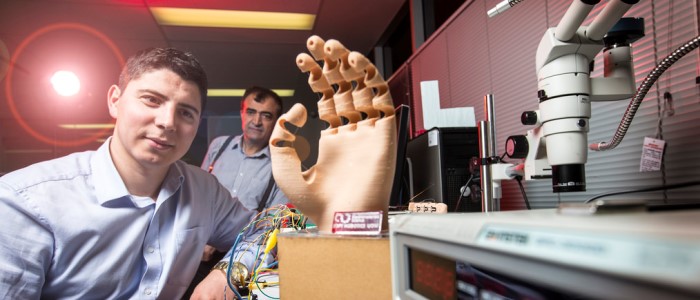News
3D printing bone tissue
Jun 28 2022
A soft robotic hand prototype that responds to neural commands like a regular limb was today unveiled by researchers from the ARC Centre of Excellence for Electromaterials Science (ACES).

Lead researcher Prof Gursel Alici, also from the University of Wollongong, said the prototype shows it is possible to create a low-cost, light, low-power prosthetic that is compatible with natural control.
“Our aim is to exploit the progress in innovative smart materials and their processing to tackle some of the most challenging research problems in the control and operation of prosthetic hands in order to bring them once step closer to their natural counterparts,” he said.
“The soft robotic hand we have made is affordable, light, made of one continuous structure and responds to signals from the brain via an interface placed on arm muscles.
“One of its key innovations is that it is made of a material that allows the joints move just like you would see in a regular hand, allowing the user to make lifelike movements.”
ACES Research Fellow, Dr Rahim Mutlu, who is responsible for the day to day running of the research project said the key is combining new, intelligent materials with 3D printing techniques.
“One of the problems with conventional robotic prosthetics is that they are made of many rigid components that are expensive to make because of the number of people involved,” he said.
“3D printing has allowed us to affordably create the hand as one structure using soft, smart materials, giving it the potential to replicate the functionality and compliance of biological limbs.”
In the next phase, the team will refine the design, replacing the motors with artificial muscles and incorporate smart materials that can help the user grasp an object, as well as provide feedback about its size, shape and temperature. The team will also advance the interface that translates brain signals into movement, with options like implantable or ‘tattoo’ electrodes on the table.
Prof Gursel demonstrated the prototype with Dr Mutlu’s help at an international electromaterials science symposium hosted by ACES at the University of Wollongong’s Innovation Campus.
“We are thrilled to be demonstrating the prototype at the ACES conference as all the right people who can help us take our prototype to the next level are in the room,” he said.
“With a team approach we are a short two years away from realising our goal.”













